Jetstar has great non-stop fares between Singapore and Yangon. We booked one way flights for less than S$100 each (for timing reasons our return flight was on SilkAir – Singapore Airlines’ sister airline). Our flight was scheduled to leave Singapore at 5:15pm and land in Yangon at 6:30pm (Myanmar is on a weird time zone that is one and a half hours behind Singapore).
The flight was about two and a half hours long but we were late getting out due to bad weather. Once in the air, the flight was fairly uneventful.
It was dark when we landed, and there was little to see out the window. A friend at work had told me the Yangon airport is very modern (built recently in partnership with Thailand), so I was a bit surprised when we disembarked directly onto the runway.
Once inside the terminal, we joined the long, disorganized queue for Immigration.

The line was not as bad as it first looked, and we waited for only about 25 minutes before our turn came. Entry to Myanmar requires an advance visa which we obtained in Singapore the week before (this is a fairly straightforward process for Singapore residents but does involve some planning and a bit of time).
There was a visa on arrival booth at the airport in Yangon but it was unmanned when we arrived. Also, it may be limited to select nationalities, so check before you plan your trip.
Once through immigration we changed US and Singapore dollars into Burmese Kyat. I had read that the currency exchanges only accept US dollars, Euros and British pounds, so it was nice to find a place that took Singapore dollars.
The line for customs was disorganized, sprawling and vaguely reminiscent of Cameroon. Everyone’s bag, regardless of size, had to go through a single scanner manned by two men who were both distractedly playing on their phones. Amy and I were able to bypass what would surely have been a long wait by simply cutting to the front of the “line” and throwing our bags on with a Burmese family.
Once through the terminal and outside, we approached two youngish looking men in official uniforms. “Taxi?” I asked and one of them blew a whistle and a taxi appeared before us. We negotiated the price to our hotel before getting in, 10,000 Burmese Kyat, or about eight US dollars. I did not see any formal taxi lines. The ride to the hotel took about half an hour.
It was Amy’s birthday weekend so we were staying at one of the city’s nicer hotels, the Park Royal Yangon. Hotels in Yangon, unlike Thailand and Vietnam, are expensive and our hotel, with breakfast included, was almost twice the rate we would normally expect to pay in one of those countries.
I was surprised to find that the Park Royal, unlike similar hotels in the area, had a metal detector and baggage scanner at the entrance.

Recently remodeled, our hotel room was clean and spacious with a comfortable bed and large bathroom. Our view was not much to write home about though.

Saturday
The morning haze brought back bad memories of Singapore last October (luckily, this haze was largely gone by early afternoon).
After breakfast, we showered and changed and then climbed into a taxi for a short ride to the Yangon Heritage Trust, the meeting point for our morning walking tour. The cab ride was delayed a bit due to a morning procession of monks requesting alms.
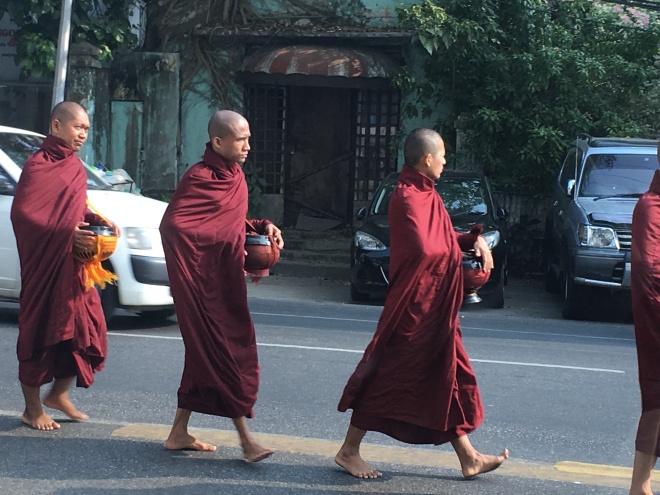
Our walking tour left from the Heritage Trust’s office next to the Yangon Port Authority (our taxi got lost trying to find the right building).
The tour is $30 per person (fairly expensive for Myanmar) but we were told proceeds are used for preservation and conservation of Yangon’s poorly maintained historic buildings. The heritage trust is also working to transform the urban downtown of Yangon by promoting a revitalized, cleaned up city with more green spaces and a friendlier river front. There is little progress right now but our guide seemed hopeful that the new government, once fully in power, will be amenable to positive change.
The tour was a great introduction to the city and its troubled past through the prism of architecture. There were only two other people on the tour with us – both US expats.
We heard about this government building which was partly destroyed in 1941 by Japanese bombs. Little has been done since to restore it to its pre-war glory.

Remarkably, many of the city’s rundown buildings (including the one above) remain occupied – either by small business owners or residential tenants.
We ventured inside this building which is occupied by several small law offices, lots of families and, disturbingly, hundreds of giant rats. See if you can spot them in the second picture amongst the basement’s garbage.


Based on their size, there doesn’t seem to be any shortage of food to scavenge.
Many of the buildings were constructed during the country’s British occupation prior to WWII. Unfortunately, many of these buildings have been poorly maintained. Architecture styles ranged the full gambit from Art Deco to neoclassical.


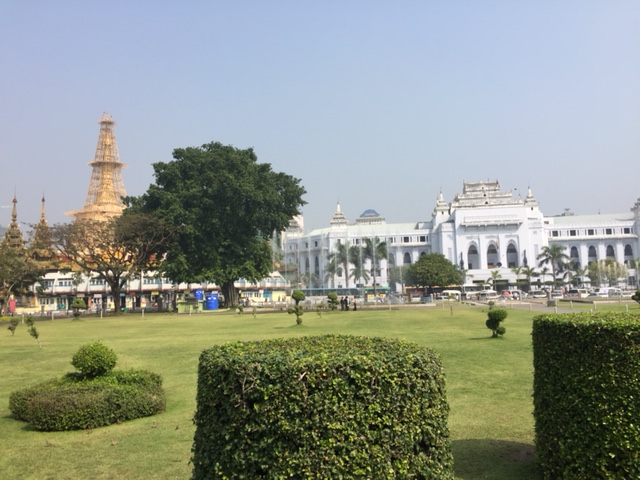
The tour left us off at Bogyoke Market (formerly known as Scotts market).
The tour ended around midday and the heat was becoming oppressive (93 degrees Fahrenheit or about 34 Celsius). Although only a few blocks away, we decided to take a taxi to the Musmeah Yeshua synagogue.
The synagogue is the only one of its kind in a city that has just five Jewish families (excluding expats). At one time the city was home to over 3,000 Jews.

We visited on a Saturday morning and were told the synagogue only hosts Friday night services now. The previous night only three people showed up, not enough for a minyan (the quorum of ten Jewish adults required for certain religious ceremonies).

After visiting the synagogue, we walked to 999 Shan Noodle, where we had a cheap but delicious meal of Burmese noodles. Popular on trip advisor, the restaurant had more tourists than locals. 999, its popularity well deserved, was clean, efficient and served a great meal.
By our glutinous western standards, the meal was rather small (similar to hawker dishes in Singapore) and so we headed over to the historic Strand Hotel for high tea.
There were two options: a traditional British high tea and a more local Burmese choice. We split one of each.


We booked a food tour of Yangon for dinner. At 6:00pm, our tour guide James met us at the hotel, and after brief introductions, we headed to Chinatown via taxi. We were the only ones on the tour.
James took us to a small restaurant and we sampled a range of local Burmese foods. Of particular note for me was the fried tofu made from chickpeas instead of soybeans and the sham noodles (sticky rice noodles similar to 999). Similar to Thai cuisine, many dishes in Burma include peanuts.
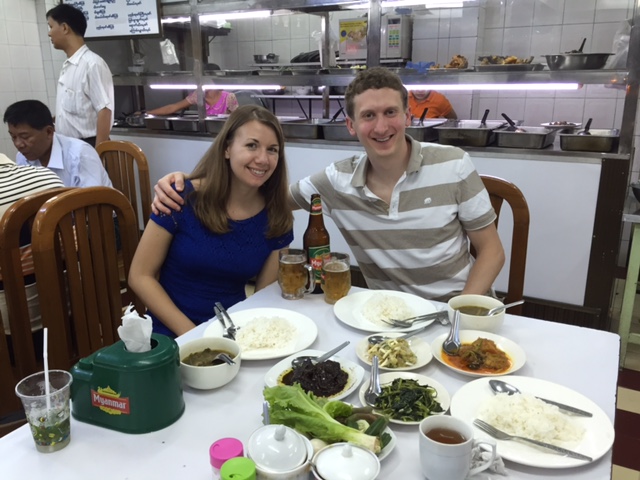

James was informative but not overly friendly. It was a bit like an awkward three person first date with stilted small talk: so what do you do in your free time? How did you get into this line of work? Etc. etc.
The food was all good though and it was nice having someone who could order for us and explain the local dishes. We went to four restaurants / food vendors in total. My favorite was probably a sidewalk fish stall in Chinatown that reminded me of the fish mamas in Cameroon. The fish was lightly seasoned and grilled perfectly.

We also enjoyed this local dessert which was reminiscent of Chendol from Penang, Malaysia.
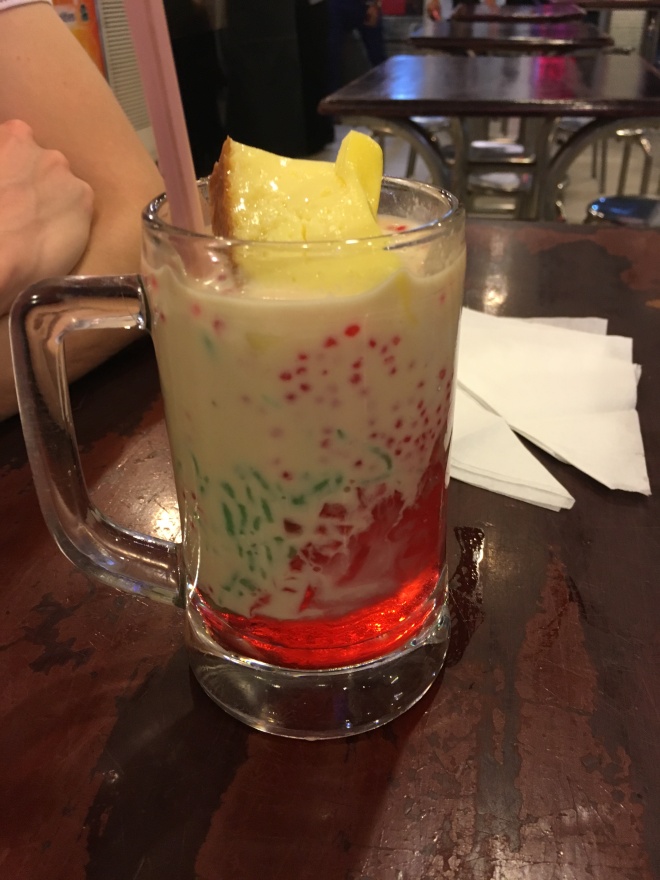
Yangon is a different city at night – much more vibrant, active and colorful.

Sunday
In the morning we ate breakfast at the hotel – I was pleasantly surprised that many of the hot dishes were new. I also explored the hotel and discovered a large state of the art fitness studio and two bars.
We left for the iconic Shewdagon Pagoda shortly after breakfast. The Buddhist temple is the tourist highlight of Yangon and it was especially crowded while we were there. This was partly due to the presence of a large cruise boat in port.

The tourists were still outnumbered by the local Burmese who came to the temple to worship and socialize at the famous pagoda.
The pagoda has a strict no shoes or socks policy and knees must be fully covered. I was required to purchase a traditional Burmese dress which i personally think looked quite flattering. I received a lot of positive feedback from locals and westerners alike (or at least that’s how I’ve chosen to interpret the laughs and pointing).
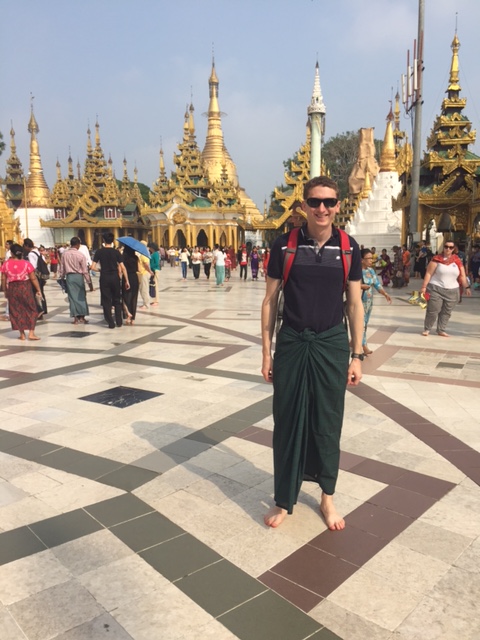

After the pagoda we went back to Scotts market and wandered through the Byzantine stalls, eventually purchasing a local acrylic impressionistic painting depicting Yangon in the rain.
We ate at one more local restaurant that served Sham noodles and other traditional dishes and then headed to the airport for our SilkAir return flight to Singapore.
A few other notes and thoughts on Yangon:
-The people were by and large friendly and helpful. At the market we found very few pushy salesmen – instead they were often reserved and rather shy.
– lots of stray animals, especially dogs roaming the city. The pagoda was crawling with cats.
– In contrast to other Southeast Asian cities (e.g. Ho Chi Minh and Bangkok), there were almost no motorbikes in the downtown area. We were told this was due to a long standing ban instituted by a former city general. Although this generally results in a less chaotic downtown it also has the unintended consequence of increasing the number of cars on the road and by extension exacerbating the already bad traffic situation.
– The taxis are all unmetered and fares should be agreed prior to departure.
